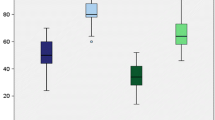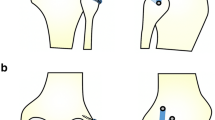Abstract
Purpose
Injuries of the posterolateral corner (PLC) are rare and severe knee injuries, resulting in posterolateral rotatory instability and an increase in external rotation. Surgical reconstruction techniques reproducing the normal anatomy showed promising results. In vivo evaluations of static rotational knee laxity at 30° of knee flexion have not been reported so far. The purpose of this study was to evaluate static rotational knee laxity after anatomic PLC reconstructions.
Methods
This is a retrospective clinical cohort study. Twenty patients with PLC reconstructions with an average follow-up time of 39 ± 22 months and no history of knee trauma or surgery of the contralateral knee were included in the study. They underwent a routine clinical examination and static rotational laxity measurements at 30° of knee flexion in the prone position. Side-to-side differences were recorded and compared to a group of matched controls.
Results
The postoperative IKDC score was graded A for 8 patients, B for 16, C for 6 and D for one patient. The primary goal of the surgical procedure which consists in reducing excessive external tibiofemoral rotation could be reached in 18 of the 20 patients (90 %). Anatomic PLC reconstructions yielded a comparable rotational profile in operated and healthy knees in 7 patients (35 %). Thirteen patients (65 %) presented a significantly altered rotational profile in comparison with a healthy control group. Unexpected increases in internal rotation were found in 8 patients (40 %).
Conclusion
Anatomic PLC reconstructions reduced excessive external tibiofemoral rotation in a vast majority of patients. Static rotational laxity measurements allowed for a determination of the patients’ individual rotational profile after PLC reconstructions. This profile was normalised in only one-third of the patients. The understanding of this finding needs further investigation as well as the clinical impact of rotational profile alterations on knee function.
Level of evidence
Diagnostic studies, Level III.



Similar content being viewed by others
Change history
20 January 2019
The original article can be found online.
20 January 2019
The original article can be found online.
References
Alam M, Bull AMJ, Thomas RD, Amis AA (2013) A clinical device for measuring internal-external rotational laxity of the knee. Am J Sports Med 41:87–94
Almquist PO, Arnbjörnsson A, Zätterström R, Ryd L, Ekdahl C, Fridén T (2002) Evaluation of an external device measuring knee joint rotation: an in vivo study with simultaneous Roentgen stereometric analysis. J Orthop Res 20:427–432
Arciero RA (2005) Anatomic posterolateral corner knee reconstruction. Arthroscopy 21:1147
Bae JH, Choi IC, Suh SW, Lim HC, Bae TS, Nha KW, Wang JH (2008) Evaluation of the reliability of the dial test for posterolateral rotatory instability: a cadaveric study using an isotonic rotation machine. Arthroscopy 24:593–598
Branch TP, Browne JE, Campbell JD, Siebold R, Freedberg HI, Arendt EA, Lavoie F, Neyret P, Jacobs CA (2010) Rotational laxity greater in patients with contralateral anterior cruciate ligament injury than healthy volunteers. Knee Surg Sports Traumatol Arthrosc 18:1379–1384
Branch TP, Siebold R, Freedberg HI, Jacobs CA (2011) Double-bundle ACL reconstruction demonstrated superior clinical stability to single-bundle ACL reconstruction: a matched-pairs analysis of instrumented tests of tibial anterior translation and internal rotation laxity. Knee Surg Sports Traumatol Arthrosc 19:432–440
Breitel D, Boisrenoult P, Leroux R, Beaufils P (2007) Plastie anatomique du point d’angle postérolatéral dans les lésions multiligamentaires du genou: résultats d’une série continue de 17 patients à court et moyen terme. Rev Chir Orthop Reparatrice Appar Mot 93:93–94
Camarda L, Condello V, Madonna V, Cortese F, D’Arienzo M, Zorzi C (2010) Results of isolated posterolateral corner reconstruction. J Orthop Traumatol 11:73–79
Fanelli GC, Edson CJ (2004) Combined posterior cruciate ligament-posterolateral reconstructions with Achilles tendon allograft and biceps femoris tendon tenodesis: 2–10-year follow-up. Arthroscopy 20:339–345
Feeley BT, Muller MS, Sherman S, Allen AA, Pearle AD (2010) Comparison of posterolateral corner reconstructions using computer-assisted navigation. Arthroscopy 26:1088–1095
Geeslin AG, LaPrade RF (2011) Outcomes of treatment of acute grade-III isolated and combined posterolateral knee injuries: a prospective case series and surgical technique. J Bone Joint Surg Am 93:1672–1683
Georgoulis AD, Ristanis S, Chouliaras V, Moraiti CO, Stergiou N (2007) Tibial rotation is not restored after ACL reconstruction with a hamstring graft. Clin Orthop Relat Res 454:89–94
Gollehon DL, Torzilli PA, Warren RF (1987) The role of the posterolateral and cruciate ligaments in the stability of the human knee. A biomechanical study. J Bone Joint Surg Am 69:233–242
Grood ES, Stowers SF, Noyes FR (1988) Limits of movement in the human knee. Effect of sectioning the posterior cruciate ligament and posterolateral structures. J Bone Joint Surg Am 70:88–97
Ho EP-Y, Lam M-H, Chung MM-L, Fong DT-P, Law BK-Y, Yung PS-H, Chan W-Y, Chan K-M (2011) Comparison of 2 surgical techniques for reconstructing posterolateral corner of the knee: a cadaveric study evaluated by navigation system. Arthroscopy 27:89–96
Hughston JC, Norwood LA Jr (1980) The posterolateral drawer test and external rotational recurvatum test for posterolateral rotatory instability of the knee. Clin Orthop Relat Res 147:82–87
Irrgang JJ, Ho H, Harner CD, Fu FH (1998) Use of the International Knee Documentation Committee guidelines to assess outcome following anterior cruciate ligament reconstruction. Knee Surg Sports Traumatol Arthrosc 6:107–114
Jung Y-B, Lee YS, Jung H-J, Nam C-H (2009) Evaluation of posterolateral rotatory knee instability using the dial test according to tibial positioning. Arthroscopy 25:257–261
Kanamori A, Lee J, Haemmerle M, Vogrin T, Harner C (2003) A biomechanical analysis of two reconstructive approaches to the posterolateral corner of the knee. Knee Surg Sports Traumatol Arthrosc 11:312–317
Krudwig WK, Witzel U, Ullrich K (2002) Posterolateral aspect and stability of the knee joint. II. Posterolateral instability and effect of isolated and combined posterolateral reconstruction on knee stability: a biomechanical study. Knee Surg Sports Traumatol Arthrosc 10:91–95
LaPrade RF (2004) An analysis of an anatomical posterolateral knee reconstruction: an in vitro biomechanical study and development of a surgical technique. Am J Sports Med 32:1405–1414
LaPrade RF, Spiridonov SI, Coobs BR, Ruckert PR, Griffith CJ (2010) Fibular collateral ligament anatomical reconstructions: a prospective outcomes study. Am J Sports Med 38:2005–2011
LaPrade RF, Terry GC (1997) Injuries to the posterolateral aspect of the knee: association of anatomic injury patterns with clinical instability. Am J Sports Med 25:433–438
Leroux R, Guillon P, Boisrenoult P, Charrois O, Beaufils P (2004) Reconstruction anatomique du plan postéro-latéral du genou à l’aide d’un transplant unique: à propos de 12 cas. Rev Chir Orthop Reparatrice Appar Mot 90:94
Lorbach O, Kieb M, Brogard P, Maas S, Pape D, Seil R (2011) Static rotational and sagittal knee laxity measurements after reconstruction of the anterior cruciate ligament. Knee Surg Sports Traumatol Arthr 20:844–850
Lorbach O, Pape D, Maas S, Zerbe T, Busch L, Kohn D, Seil R (2010) Influence of the anteromedial and posterolateral bundles of the anterior cruciate ligament on external and internal tibiofemoral rotation. Am J Sports Med 38:721–727
Lorbach O, Wilmes P, Maas S, Zerbe T, Busch L, Kohn D, Seil R (2009) A non-invasive device to objectively measure tibial rotation: verification of the device. Knee Surg Sports Traumatol Arthr 17:756–762
Lorbach O, Wilmes P, Theisen D, Brockmeyer M, Maas S, Kohn D, Seil R (2009) Reliability testing of a new device to measure tibial rotation. Knee Surg Sports Traumatol Arthr 17:920–926
Markolf KL, Graves BR, Sigward SM, Jackson SR, McAllister DR (2007) Effects of posterolateral reconstructions on external tibial rotation and forces in a posterior cruciate ligament graft. JBJS Am 89:2351–2358
McCarthy M, Camarda L, Wijdicks CA, Johansen S, Engebretsen L, LaPrade RF (2010) Anatomic posterolateral knee reconstructions require a popliteofibular ligament reconstruction through a tibial tunnel. Am J Sports Med 38:1674–1681
Mouton C, Seil R, Agostinis H, Maas S, Theisen D (2012) Influence of individual characteristics on static rotational knee laxity using the Rotameter. Knee Surg Sports Traumatol Arthrosc 20:645–651
Mouton C, Theisen D, Pape D, Agostinis H, Krecke R, Seil R (2012) Normative references and minimum detectable change in anterior and rotational knee joint laxity measurements. Knee Surg Sports Traumatol Arthrosc 20:S196
Musahl V, Bell KM, Tsai AG, Costic RS, Allaire R, Zantop T, Irrgang JJ, Fu FH (2007) Development of a simple device for measurement of rotational knee laxity. Knee Surg Sports Traumatol Arthr 15:1009–1012
Nau T, Chevalier Y, Hagemeister N, deGuise JA, Duval N (2005) Comparison of 2 surgical techniques of posterolateral corner reconstruction of the knee. Am J Sports Med 33:1838–1845
Nau T, Chevalier Y, Hagemeister N, Duval N, deGuise JA (2005) 3D kinematic in vitro comparison of posterolateral corner reconstruction techniques in a combined injury model. Knee Surg Sports Traumatol Arthrosc 13:572–580
Noyes FR, Barber-Westin SD (1995) Surgical reconstruction of severe chronic posterolateral complex injuries of the knee using allograft tissues. Am J Sports Med 23:2–12
Park H, Wilson N, Zhang L (2008) Gender differences in passive knee biomechanical properties in tibial rotation. J Orthop Res 26:937–944
Rios CG, Leger RR, Cote MP, Yang C, Arciero RA (2010) Posterolateral corner reconstruction of the knee: evaluation of a technique with clinical outcomes and stress radiography. Am J Sports Med 38:1564–1574
Sekiya JK, Haemmerle M, Stabile K, Vogrin T, Harner C (2005) Biomechanical analysis of a combined double-bundle posterior cruciate ligament and posterolateral corner reconstruction. Am J Sports Med 33:360–369
Veltri DM, Deng X-H, Torzilli PA, Warren RF, Maynard MJ (1995) The role of the cruciate and posterolateral ligaments in stability of the knee: a biomechanical study. Am J Sports Med 23:436–443
Acknowledgments
The present project is supported by the National Research Fund, Luxembourg.
Conflict of interest
The authors declare that they have no conflict of interest.
Author information
Authors and Affiliations
Corresponding author
Rights and permissions
About this article
Cite this article
Tardy, N., Mouton, C., Boisrenoult, P. et al. Rotational profile alterations after anatomic posterolateral corner reconstructions in multiligament injured knees. Knee Surg Sports Traumatol Arthrosc 22, 2173–2180 (2014). https://doi.org/10.1007/s00167-013-2655-0
Received:
Accepted:
Published:
Issue Date:
DOI: https://doi.org/10.1007/s00167-013-2655-0




